Here are a few snapping turtle facts to start us off. These chelonians are endemic to North America with most of the population found in the United States.
Contrary to popular belief, there are five snapping turtle types/species. These are the alligator snapping turtle, the common snapping turtle, the Suwannee snapping turtle, South American snapping turtle, and the Central American snapping turtle.
Snapping turtles are fascinating chelonians. Not only are they well known for their vicious bites, but also they are also commonly kept as pets.
This reptile has also been featured in politics. It was used to protest the Jeffersonian Embargo Act of 1807. More recently, in 2006, the common snapping turtle was chosen to be the state reptile of New York.
Table of Contents
Here are some more fascinating and enlightening facts about one of America’s more endearing reptiles:
Types of Snapping Turtles

Snapping turtles belong to the family Chelydridae which belongs to the order Testudines (this simply means that they are turtles).
As mentioned earlier in the introduction. There are five snapping turtle species in existence.
these are the alligator snapping turtle(Macrochelys temminckii), the common snapping turtle (Chelydra serpentina), the Suwannee snapping turtle (Macrochelys suwanniensis), the Central American snapping turtle (Chelydra rossignonii), and the South American snapping turtle (Chelydra acutirostris).
All of these species are predators and excellent hunters. All of these species are capable of causing severe injuries when provoked.
These apex predators are not to be messed with. You can identify these turtles by their rugged appearance.
Snapping turtles look very much like armored dinosaurs such as the Ankylosaurus from the Cretaceous Period.
There are also several extinct snapping turtle genii and species. We won’t go into details about that as they are extinct.
Most of these species went extinct some 5 to 20 million years ago, long before humans existed in the Americas. A few extinct snapping turtle species include Macrochelys auffenbergi, Macrochelys schmidti, and Chelydra floridana.
General Information And Facts About Snapping Turtles
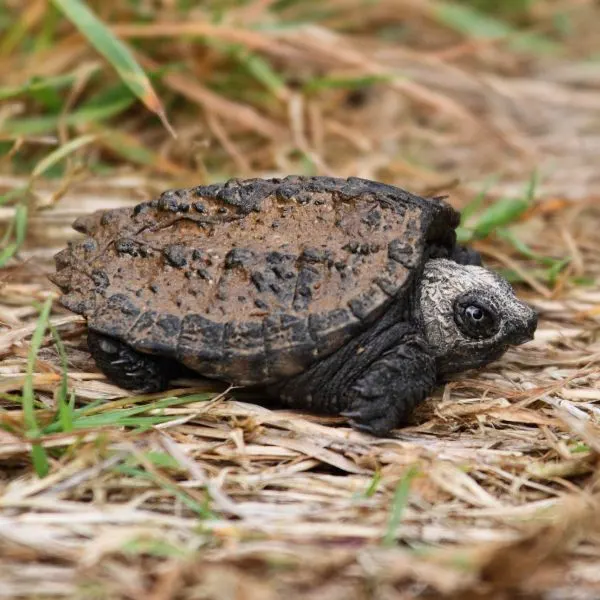
Here are some general information and facts about snapping. Some you may already know and some will come as a surprise.
Snapping turtles refer to turtles of the family Chelydridae. “What is a family?” you may ask.
In biology, this is a hierarchical rank and is a way to group all animals that share similar characters and features.
All snapping turtles look crocodilian and have long tails, rough-looking shells, and sharp jaws that can cause serious injuries. The family Chelydridae are also large in size and are apex predators.
Snapping turtles belong to the class Reptilia, which includes all reptiles. They also belong to the phylum Chordata which includes all species that have notochords at least during a period of their lives.
The notochord develops to become part of the spinal column. These chelonians also belong to the kingdom Animalia which includes all animals.
In terms of appearance, snapping turtles have tubercles on their necks and limbs. These give them the rugged appearance they are known for.
The Suwannee and alligator snappers look most crocodilian. This is down to their rugged rough carapace that has spikes. These spikes are arranged in three rows that go down the length.
Snapping turtles are capable predators. Some, such as the Suwannee snapper and the alligator snapper can bite off human fingers clean off.
Their jaws can cause serious injuries such as broken bones, cuts, and lacerations among others. As such, you should always approach a snapping turtle with caution or not approach it at all.
In the wild, these chelonians just want to be left alone.

Snapping turtles are long-lived and have a lifespan well above 100 years. If you plan to keep a snapping turtle as a pet, be aware that it can outlive you.
A snapping turtle may also live to be just 45 years. However, if the turtle doesn’t suffer from any life-threatening accident or illness, it should live up to 45 years and above.
Snapping turtles are omnivores, although they are more carnivorous than herbivorous. They eat more animal matter than they do plant matter.
Plants they eat include vegetation such as weeds, fruits, nuts, and many more. They also mostly eat fish, other turtles, alligators, birds, snakes, crawfish, and snails. They mostly hunt in water where they have the advantage.
Snapping turtles breed once a year. A single gravid female can lay about 30 eggs which incubate for about 120 days before hatching. Females and males reach maturity around the age of 12 years.
The plastron of snappers is tiny. Their carapace, on the other hand, is huge. It is safe to say that plastron does little to protect the turtle.
Luckily for the snapping turtle, it is usually on the attack and rarely on the defensive. However, they are usually in trouble when they meet humans that hunt them.
As adults, snapping turtles have few to no predators within their habitat. Juveniles, hatchlings, and eggs do have several predators. It is safe to say that the top predator of the snapping turtle is humans.

Snapping turtles mate between April and November. Females mate once a year or once every alternating year.
Nesting females cover long distances to lay eggs. They cover their eggs with mud or sand after digging a hole in a suitable nesting spot.
All turtles carry salmonella. Wash your hands thoroughly after touching a turtle.
Salmonella can also enter the body through an open wound so make sure you visit the hospital and have a doctor check any snapping turtle lacerations.
Snapping turtles do not seem to bother anglers or boats.
Hatchlings can hunt and bite the moment they hatch.
Snapping turtles may hibernate from Fall to Spring (October to April). They may hibernate as a group or as individuals.
Snapping turtles that are captive-bred and raised by humans are generally docile towards people.
There are no recorded human deaths caused by snapping turtles although there are a few reported cases of finger amputations caused by snapping turtles specifically alligator snapping turtles.
Alligator Snapping Turtle Facts

Macrochelys temminckii is the binomial name of the alligator snapping turtle. It belongs to the family Chelydridae and the genus Macrochelys.
This turtle is one of the world’s largest and heaviest freshwater turtles. Some biologists even considered them the world’s largest freshwater turtle species when you take the average weight of a specimen within the species.
The alligator snapper is unarguably the largest freshwater turtle native to North America. This chelonian can easily reach a weight of 176 lbs or 80 kg.
The average alligator snapping turtle has a weight of 154 to 176 lb. in terms of carapace length, the alligator snapping turtle can reach 31 to 40 inches or 79 to 101 cm.
Alligator snapping turtles are solitary creatures that live alone and have almost no social structure. If you plan on keeping one as a pet, make sure that you do not house it with another animal.
Alligator snapping turtles look primitive. They have huge heads with powerful jaws and a rugged shell with three large ridges made up of spiky protrusions. From their appearance, it is clear to be cautious when approaching them.
Females mostly lay just a single clutch per year. Also, a large portion of mature females lay eggs once every two years.
The species generally mate in early spring to late spring and nest two months after successfully mating. The eggs then incubate for about 120 days.
In 2013, the first alligator snapping turtle found in Oregon was euthanized as the species is considered to be invasive.
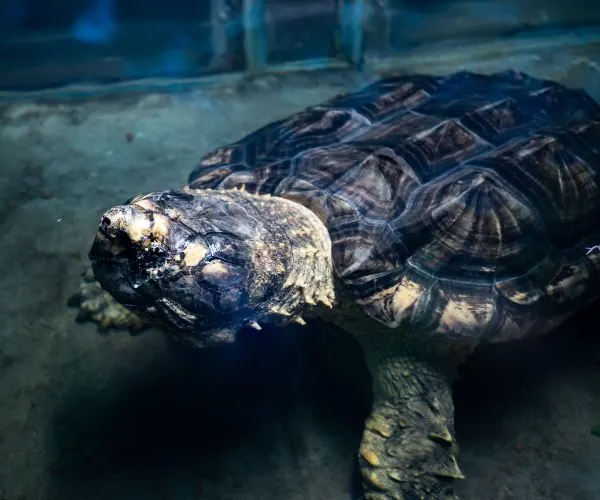
Like most freshwater turtles, the alligator snapping turtle is predominantly aquatic. The only time, alligator snappers come out of water is when gravid females need to nest on land.
M. temminckii consumes a large amount of food and is capable of significantly impacting the local population of fish species in a habitat. They also eat a large amount of decaying organisms and as such help clean their ecosystems.
M. temminckii eat fish, plants, clams, snails, snakes, frogs, and even other turtles. They also eat mammals such as armadillos, raccoons, possums, muskrats, squirrels, and nutria.
M. temminckii thermoregulates its body temperature by moving between streams of different depths. During the winters, they prefer deeper streams and during the summer, they prefer shallower streams.
M. temminckii use their worm-shaped tongue to lure fish into their open mouths. They then impale the fish with the pointy tips of their jaws or cut them into two with their sharp jaws or swallow them whole.
Snapping turtles are considered to be an invasive species in several European countries such as Hungary, the Czech Republic, and Germany where an alligator snapping turtle is suspected to have seriously injured a child. The turtle has since been named Lotti.
The alligator snapping turtle eats other turtles. Turtles were found in the stomachs of 90% of all alligator snappers sampled in a Louisiana study. They are adept at hunting musk and mud turtles. They do this by sampling the chemical composition of the surrounding waters. They can detect chemicals released by prey such as musk and mud turtles. Their main means of perception include visual and chemical.
The main threats to the wild population of this turtle are habitat destruction and alteration and pesticide accumulation. Another major threat is overharvesting for human consumption.
M. temminckii is considered endangered in Missouri, Kentucky, Illinois, and Indiana. In Kansas, the state has designated it as a species “in need of conservation”. In Tennessee, Missouri, Indiana, Georgia, Florida, and Arkansas, it is illegal to take an alligator snapping turtle out of its natural habitat. In Texas, Oklahoma, Louisiana, Kansas, Illinois, and Alabama, you can hunt and remove an alligator snapping turtle from its natural habitat as long as you have the required permit.
The species has a status of ‘Vulnerable’ on the IUCN Red List. The species is also included in CITES Appendix III (US).
M. temminckii holds the status of G3 (Vulnerable) on the Nature Serve. It holds a national status of N3 in the United States.
The species hold a no COSEWIC (Committee on the Status of Endangered Wildlife in Canada) status.
The species hibernates during the colder seasons.
The species have very few predators. The only known predator of mature individuals is Homo sapiens (humans). Other animals such as birds, Actinopterygii (ray-finned fish), and raccoons are known to eat hatchlings and unhatched eggs.
The species live significantly shorter lives in the wild as compared to in captivity. The average lifespan of the species in captivity is 70 years according to AnAge. According to ADW, the average lifespan of the species in the wild is 11 to 45 years.

The species prefer water bodies with a lot of covers in the way of overhanging shrubs, logs, and even beaver dams.
The temperature of the nest determines the sex of the hatchlings. Higher temperatures results in mostly females and lower temperatures result in males mostly. 25 to 27 degrees results in mostly males and 29 to 30 degrees celsius results in all females.
There are laws against the exotic trade of alligator snapping turtles including the harvest for meat and particularly for the international pet trade.
These chelonians can stay underwater for 40 to 50 miniatures before they need to resurface to breathe.
They usually remain very still when underwater. As such, there is usually algae growing on the back of the species. This alga helps the species to blend into their environment. This is useful when they have to hunt.
Unlike the common snapping turtle, the alligator snapping turtle has eyes on the side of the head.
Within the species, males are larger than females. Males also have longer tails than females do.
The Apalachicola snapping turtle (Macrochelys apalachicolae) is a species that was proposed in 2014. This proposed species is the Apalachicola River subpopulation of the alligator snapping turtle.
Common Snapping Turtle Facts
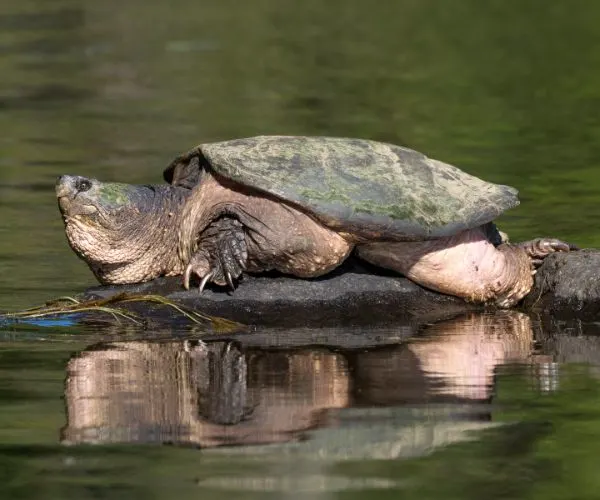
The common snapping turtle’s binomial (scientific) name is Chelydra serpentina.
Adult snapping turtles have few predators besides humans. They will defeat themselves viciously when attacked and can cause serious injuries to predators. As such adults don’t have natural predators besides humans. Hatchlings and eggs on the other hand have several predators. Some of these predators include crows, water snakes, bullfrogs, largemouth bass, red foxes, striped skunks, raccoons, and great blue herons.
Although quite large, the common snapping isn’t as large as the alligator snapping turtle (Macrochelys temminckii). It is still quite late when compared to other North American turtles. This chelonian’s shell can grow from 8 to 18.5 inches which are about 20 to 40 cm. The tail is almost about the same length as the shell.
C. serpentina can be found in tidal creeks, hill streams, temporary ponds, marshes, reservoirs, lakes, and even rivers.
C. serpentina eggs take 75 to 95 days to hatch.

C. serpentina faces a large number of threats. This is to be expected as the species is a favorite in turtle soups and stews. In many parts of the US and Canada, the collection and trade of the species are regulated. In Nova Scotia, Ontario, Saskatchewan, Manitoba, and Alberta the species is considered to be of “Special Concern”. Some threats the species face include overexploitation, habitat degradation and loss, and pollution.
C. serpentina holds the status of “Least Concern” on the IUCN Red List. The species is also included in CITES Appendix III (US).
C. serpentina holds the status of G5 (Secure) on the Nature Serve. It holds a national status of N4 in Canada and N5 in the United States.
The species hold a COSEWIC (Committee on the Status of Endangered Wildlife in Canada) status of Special Concern.
Females reach reproductive maturity at age 9 to 18 years. Males reach reproductive maturity at age 4 to 6 years.
In Canada, they can be found in Saskatchewan, Quebec, Ontario, Nova Scotia, New Brunswick, and Manitoba. In the United States, they can be found in almost every single state on the mainland.

In the wild, C. serpentina will bury itself in the muddy bottom of its habitat. This is their way of ambushing potential prey.
In the wild, the snapping turtle is estimated to have a lifespan of about 30 years. In captivity, however, the species have a maximum lifespan of about 47 years. According to Max Planck Institute for Demographic Research, the species have a lifespan of about 17.8 in captivity. As you can see, this is much lower than their average lifespan in the wild.
Males are generally larger than females are. Mature males are usually 19 inches or 49 cm in carapace length while mature females are 14.5 inches or 37 cm in carapace length.
Outside of North America, the species have been introduced to Japan, the United Kingdom, the Netherlands, and Taiwan.
Snapping turtles are commonly used as an ingredient in turtle soups and stews. Even the shells are used in Native American ceremonies.
Snapping turtles have been introduced to California, Nevada, Arizona, and Oregon. They are not endemic to these states.
The common snapping turtle is solitary and is usually aggressive towards other turtles including other snapping turtles. Males are generally more aggressive towards one another. Regardless of this aggression, it is common to find many common snapping turtles within the same ecosystem. When this happens, they stay out of each other’s way.
The common snapping turtle is usually referred to as the snapping turtle.
The common snapping turtle’s geographic range starts from S. Alberta to Nova Scotia in Canada and then from Canada all the way to central Texas and the Gulf of Mexico. It has one of the largest ranges of any reptile in North America. It is called common for a reason.
The number of eggs that gravid females lay increases with latitude. The species can lay 25 to 45 eggs in a single go.
The snapping turtle is not a picky eater. Usually omnivorous, C. serpentina eats amphibians, small mammals, birds, fish, invertebrates, and even carrion.
If the animal can fit inside the mouth, C. serpentina would eat it. They also eat a lot of vegetation. C. serpentina also hunts and eats other turtles. They are known to decapitate other turtles before feeding on them.
The species are gentle and docile when in water but get very aggressive when out of water. Outside of water, C. serpentina is more likely to attack a human.
The species is protected by different legislations and regulations from one state to another in the United States. In most states, the capture of C. serpentina is regulated.
In Michigan, the capture of the species is prohibited. In Texas, New York, Maryland, Alabama, and many other states the hunting/capture of the species is regulated including restrictions on commercial use, gear, and area; closed seasons; and bag limits and size.
This chelonian carapace (upper shell) is tan to dark brown and even black in coloration. Similar to the alligator snapper, the common snapper has a tiny plastron that provides little protection. The limbs, neck, and tail of the C. serpentina are yellowish and the head is dark.
This turtle can be found in both brackish and freshwater. Brackish water refers to slightly salty water. Habitats they prefer usually have a lot of cover/vegetation and muddy bottoms. The turtle hides in these muddy bottoms and the vegetation provides ample concealment.
Suwannee Snapping Turtle Facts
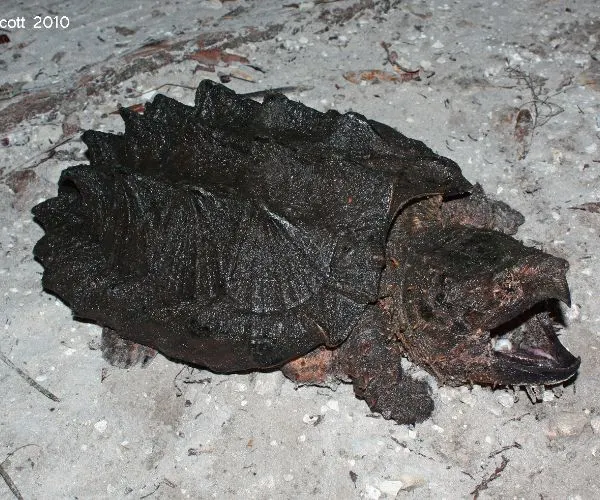
Suwannee snapping turtle binomial (scientific) name is Macrochelys suwanniensis.
In 2021, a single Suwanee snapping turtle was discovered in the Okefenokee Swamp. Perhaps, there is a wild population living in this swamp.
Suwannee snapping turtle can only be found in the Suwannee river basin. This turtle gets its common name from its geographic range. The Suwannee River is a blackwater river that is about 246 miles or 396 km long. The river runs from Georgia to Florida.
In 2021, U.S. Fish and Wildlife Service included M. suwanniensis on the proposed lists of species to be protected under the ESA (Endangered Species Act).
The adult population of the species is estimated to be less than 2,000.
The species’ geographic range and habitats are in wildlife refuges and state parks including Lower Suwannee River National Wildlife Refuge, Suwannee River State Park, River Rise State Park, O’leno State Park, Manatee Springs State Park, Ichetucknee Springs State Park, and Stephen Foster State Park.

The status of the Suwannee snapping turtle as a separate species is not widely reflected in many publications. It is yet to reflect on IUCN Red List.
The species was once considered to be a population of the more widespread alligator snapping turtle (M. temminckii). A study in 2014 found that genetic divergence between the alligator snapping turtle (M. temminckii) and Suwannee snapping turtle (M. suwanniensis) dates back to about 5.5 to 13.4 million years ago ( about 5.5 to 13.4 million years ago). As such, the Suwannee population of snapping turtles is described as a separate species.
M. suwanniensis holds a conservation status of G2 (Imperiled) on NatureServe. This is because the turtle is limited to just one river basin. The species hold an N2 status in the United States and an S2 status in Georgia and Florida.
M. suwanniensis is endemic to the northern parts of the Suwannee River basin in Florida and southern Georgia. T can be found in riverine habitats including the tributaries of the Suwannee River. It can be found in oxbows, and backwater swamps as well. While some individuals live in inland lakes, these are suspected to have been introduced.
Central American Snapping Turtle Facts
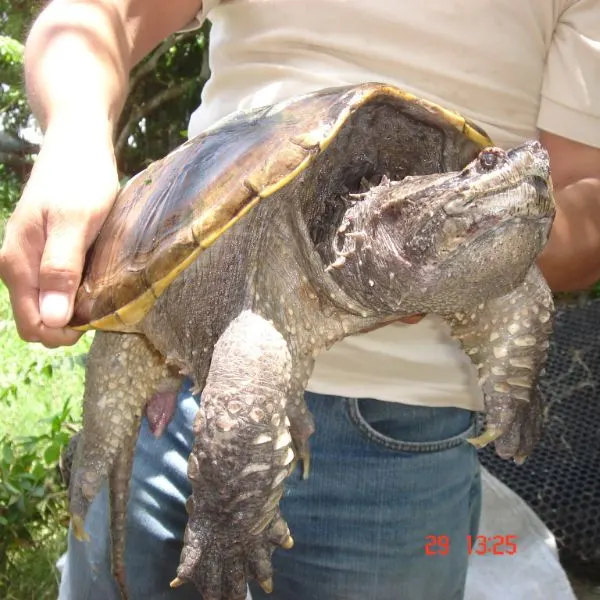
Central American snapping turtle binomial (scientific) name is Chelydra rossignonii.
C. rossignonii can be found in Mexico (Veracruz), Belize, Honduras, and Guatemala.
C. rossignonii is aquatic and hardly ever leaves its aquatic habitat. The chelonian does not even bask.
C. rossignonii is known to feed on small vertebrates, fish, aquatic insects, frogs, clams, crabs, shrimps, and prawns. They are also known to eat fruits, plants, and algae. They are omnivorous.
C. rossignonii is sometimes considered to be a subspecies of the Common snapping turtle under the synonym Chelydra serpentina rosignonii.
In Chiapas, the southernmost state of Mexico, the species nest from April to June and late about 20 to 30 eggs.
In Guatemala, the species is known to inhabit backwater sloughs, slow current rivers, oxbows, and occasionally large rivers. The species do not live in clear water rivers, streams, or lakes. The species can be found in murky water that has a lot of vegetation and debris.

Juveniles and hatchlings have white speckles.
The central snapping turtle is also known as the Yucatan snapping turtle and the Mexican snapping turtle.
The species have a tiny plastron that is gray, yellowish, cream, or tan. The carapace on the other hand can be black to olive or brown.
The species is consumed as food by humans. This is the main threat that C. rossignonii faces.
C. rossignonii has a status of ‘Vulnerable’ on the IUCN Red List.
The species is protected under wildlife legislation in both Mexico and Guatemala. Implementation of these legislations is poor.
A conservation breeding program also breeds the species in Nacajuca, a city in the state of Tabasco.
The species may occur in many national parks in Honduras, Guatemala, and Mexico.
Turtle breeders in southern Veracruz commercially farm the central snapping turtle for the pet trade.
While there is little documentation on the size of the species, an individual female was measured in Honduras. This individual weighed about 26 lb (12 kg) and measured a length of about 14.6 inches (37 cm).
South American Snapping Turtle Facts

South American snapping turtle binomial (scientific) name is Chelydra acutirostris.
C. acutirostris can be found in northwestern South America and Central America.
Its geographic range in South America is limited. This indicated that the species is part of the Great American Biotic Interchange which occurred about 2.7 million years ago.
The species is endemic to Ecuador, Colombia, Panama, Costa Rica, Nicaragua, and Honduras.
Frequently Asked Questions
Are snapping turtles good pets?
Many consider snapping turtles to be excellent pets. The alligator snapping turtle has been described as the best pet monster. Regardless of opinions, snapping turtles are popular pets although they are capable of delivering serious bites that can cause serious injuries.
While they may be tiny when young, they grow to be huge as adults and as such require a large enclosure and a pool. They take a lot of space.
They require a lot of food as well.
While they are relatively straightforward to care for, they require a lot of space and can be expensive to keep.
Can you legally keep snapping turtles as pets?
In Canada, it is illegal to own common snapping turtles. In many places across the world, it is illegal to keep snapping turtles as they are invasive species.
However, in many parts of the United States, it is perfectly legal to keep a snapping turtle as a pet. Before you acquire any pet, make sure that it is legal to keep that animal as a pet. The laws vary from one locale to another.
Are snapping turtles easy to keep?
It is relatively easy to care for and keep snapping turtle. This is especially true if the weather and temperature of your locale match that of the geographic range of the chelonian. These chelonians are also hardy and don’t require too much attention.
The main issue here is the cost and resources that go into establishing an enclosure for the turtle. They are large reptiles and as such require large enclosures. They also require a lot of food although they aren’t picky eaters.
Are snapping turtles endangered?
No snapping turtle is endangered on the IUCN Red List. However, some species are considered endangered in some places. The alligator snapping turtle is considered endangered in Indiana, Missouri, Illinois, and Kentucky.
M. temminckii (alligator snapper) and C. rossignonii (Central American snapper) are considered to be vulnerable species on the IUCN Red List.
Similarly, several of the species also hold threatened conservation status. M. temminckii (alligator snapper) holds a Vulnerable status on Nature Serve. While the common snapper – C. serpentina – holds a status of Special Concern in Canada.
Conclusion
Snapping turtles are interesting animals. They may be turtles but they are not slow nor are they docile and friendly.
While they prefer to be left alone they will defend themselves when threatened. They can defend themselves with their strong jaws which are capable of delivering serious lacerations and broken bones.
The five snapping turtles covered are five and these include the well-known alligator snapping turtle and common snapping turtle and the lesser-known South American snapping turtle, and the Central American snapping turtle. These chelonians can be found on both the North American and South American continents.
The common and alligator snapping turtles are endemic to North America while the central and South American snapping turtles are endemic to Central and South America.

Cherie Everett
Tuesday 10th of September 2019
Do snapping turtles feed on fish in my farm pond?
rick osten
Saturday 24th of August 2019
there great animals and make good pets but can be messy when real big. they always look like something you want to show off to friends cause theres nothing more interesting.
Daniel
Sunday 30th of June 2019
I found a turtle but a don’t now if it’s a snapping turtle
Molly Kaye
Saturday 31st of August 2019
When I was a little girl, I had a pet turtle for awhile that we caught from a creek on our farm. I let it go after awhile because we felt it was better off in the wild. I got to observe and still have a fondness for turtles. I was walking close to a pond on our land when I saw a fairly big turtle and picked it up toward the back of it's shell. It hissed and a Very long neck shot a beak toward my hand. I had picked up a snapping turtle. I dropped it, it crawled away after awhile and I became much more careful about identifying what I was handling. I think if you have a snapping turtle and handle it, it will be obvious. Just be careful as they will sincerely try to bite and a large snapper can take off a finger.
AllTurtles
Monday 1st of July 2019
There is either the common snapping turtle or alligator snapping turtle, have a look at our turtle species page and compare them. If you are still unsure send us an email at [email protected] with a few pics and we will try to help.